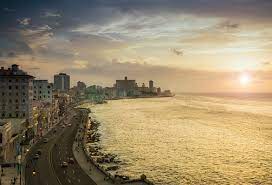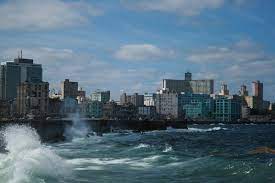EL MALECÓN DE LA HABANA, CUBA: AYER Y HOY EN EL IMPRESCINDIBLE LUGAR DE REUNIÓN PARA LA POBLACIÓN. PHOTOS
El lugar de mayor expansión para los habitantes de la capital cubana es El Malecón.
El Malecón (oficialmente Avenida de Maceo) es una amplia explanada, calzada y malecón que se extiende a lo largo de 8 km (5 millas) a lo largo de la costa de La Habana, Cuba, desde la desembocadura del Puerto de La Habana en La Habana Vieja, a lo largo del norte. lado del barrio Centro Habana y el barrio Vedado, finalizando en la desembocadura del río Almendares.
La historia del Malecón habanero es realmente interesante.
La construcción del Malecón comenzó en 1901, durante el gobierno militar temporal de Estados Unidos. El objetivo principal de la construcción del Malecón fue proteger La Habana del mar.
Para celebrar la construcción del primer tramo de 500 m del Malecón, el gobierno estadounidense construyó una rotonda en la intersección del Paseo del Prado. Según arquitectos de la época fue la primera rotonda en Cuba construida con hormigón armado con acero. Allí las bandas tocaban melodías cubanas todos los domingos. Frente a la rotonda se construyó el Hotel Miramar. Fue el primer hotel de Cuba donde los camareros vestían esmoquin (esmoquin) y chalecos (chalecos) con botones dorados, y estuvo muy de moda durante los primeros 15 años de la independencia.
Los gobiernos cubanos posteriores continuaron la ampliación del primer tramo del Malecón. En 1923 llegó a la desembocadura del río Almendares entre las calles K y L del Vedado, donde se construyó la Embajada de Estados Unidos, cerca del Parque Deportivo José Martí y, más lejos, el Hotel Rosita de Hornedo (hoy Sierra Maestra).
En 1957 y 1958, la calzada sirvió como sede del Gran Premio de Cuba.
PUNTOS DE INTERÉS
Hay varios monumentos importantes a lo largo del Malecón, incluidos los del General Máximo Gómez, Antonio Maceo, el General Calixto García y el Monumento a las Víctimas del USS Maine.
En la intersección de la calle 23, el Malecón marca el extremo noreste del tramo La Rampa de la calle 23, Vedado.
En la Plaza de la Dignidad se encuentra una estatua de José Martí y frente a la Embajada de Estados Unidos, la Plataforma Antiimperialista José Martí.
Entre los edificios significativos se encuentran el Castillo de la Real Fuerza, el Castillo de San Salvador de la Punta, el Malecón 17 (Las Cariátides) y el Hotel Nacional.
Hubo varios edificios, monumentos y accidentes geográficos que formaron parte del Barrio de San Lázaro entre ellos el Torreón de San Lázaro, La Casa de Beneficencia, el Hospital de San Lázaro, el Cementerio de Espada, la Casa de Dementes de San Dionisio, la Cantera. de San Lázaro, la Batería de la Reina, la Batería de Santa Clara y el Cerro de Taganana, entre otros.
EL MALECÓN DE HOY
En la actualidad, el Malecón habanero sigue siendo el lugar más concurrido de los cubanos, sobre todo por los cubanos de a pie que carecen de medios económicos para frecuentar una discoteca cuyo pago es en divisas, o un hotel, todos exclusivos para extranjeros.
Además, es conocido por todos que el Malecón es fuente de ingresos para familias muy pobres, que durante las horas nocturnas realizan la pesca como medio de subsistencia.
Espectáculos realmente deprimentes pueden verse también en el Malecón habanero, cuando la policía casi de forma permanente vigila a las mujeres y hombres jóvenes que andan a la caza de turistas para ejercer el oficio más antiguo de la humanidad.
A pesar de verse casi en ruinas las antiguas y valiosas edificaciones que van de forma paralela al Malecón, tras ser detenido el desarrollo arquitectónico a partir del triunfo del régimen castrista, aún es muy bello el litoral de la capital. Tanto los cubanos como aquellos que nos visitan, no dejan de visitar y admirar uno de los lugares más hermosos de La Habana.
THE MALECÓN OF HAVANA, CUBA: YESTERDAY AND TODAY IN THE ESSENTIAL MEETING PLACE FOR THE POPULATION. PHOTOS
The most expansive place for the inhabitants of the Cuban capital is El Malecón.
The Malecón (officially Avenida de Maceo) is a wide esplanade, causeway and seawall that extends for 8 km (5 mi) along the coast of Havana, Cuba, from the mouth of the Port of Havana in Old Havana, along the north. side of the Centro Habana neighborhood and the Vedado neighborhood, ending at the mouth of the Almendares River.
The history of the Havana Malecón is really interesting.
Construction of the Malecón began in 1901, during the temporary military government of the United States. The main objective of the construction of the Malecón was to protect Havana from the sea.
To celebrate the construction of the first 500m stretch of the Malecón, the US government built a roundabout at the Paseo del Prado intersection. According to architects of the time, it was the first roundabout in Cuba built with steel-reinforced concrete. There the bands played Cuban melodies every Sunday. The Miramar Hotel was built in front of the roundabout. It was the first hotel in Cuba where the waiters wore tuxedos (tuxedos) and vests (vests) with gold buttons, and it was very fashionable during the first 15 years of independence.
Subsequent Cuban governments continued the expansion of the first section of the Malecón. In 1923 he arrived at the mouth of the Almendares River between K and L streets in Vedado, where the United States Embassy was built, near the José Martí Sports Park and, further away, the Hotel Rosita de Hornedo (today Sierra Maestra).
In 1957 and 1958, the road served as the venue for the Cuban Grand Prix.
POINTS OF INTEREST
There are several important monuments along the Malecón, including those of General Máximo Gómez, Antonio Maceo, General Calixto García, and the Monument to the Victims of the USS Maine.
At the intersection of 23rd Street, the Malecón marks the northeastern end of the La Rampa section of 23rd Street, Vedado.
In the Plaza de la Dignidad there is a statue of José Martí and in front of the United States Embassy, the José Martí Anti-imperialist Platform.
Among the significant buildings are the Castillo de la Real Fuerza, the Castillo de San Salvador de la Punta, Malecón 17 (Las Cariátides) and the Hotel Nacional.
There were several buildings, monuments and geographical features that were part of the San Lázaro neighborhood, including the San Lázaro Tower, the Casa de Beneficencia, the San Lázaro Hospital, the Espada Cemetery, the San Dionisio House for the Insane, the Quarry . of San Lázaro, the Queen’s Battery, the Santa Clara Battery and the Taganana Hill, among others.
TODAY’S MALECON
Currently, Havana’s Malecón continues to be the most popular place for Cubans, especially for ordinary Cubans who lack the financial means to frequent a discotheque whose payment is in foreign currency, or a hotel, all exclusively for foreigners.
Furthermore, it is known by all that the Malecón is a source of income for very poor families, who during the night hours fish as a means of subsistence.
Truly depressing spectacles can also be seen on Havana’s Malecón, when the police almost permanently monitor the young women and men who are hunting for tourists to practice the oldest profession of humanity.
Despite the old and valuable buildings that run parallel to the Malecón being almost in ruins, after architectural development was stopped after the triumph of the Castro regime, the capital’s coastline is still very beautiful. Both Cubans and those who visit us do not stop visiting and admiring one of the most beautiful places in Havana.
Agencies/ Wiki/ Tania Díaz/ xractos/ Excerpts/ Internet Photos/ Arnoldo Varona/ www.TheCubanHistory.com
THE CUBAN HISTORY, HOLLYWOOD.



 EL MALECÓN de la Habana, Cuba: Ayer y Hoy en el Imprescindible Lugar de Reunión para la Población. PHOTOS. * THE MALECÓN of Havana, Cuba: Yesterday and Today in the Essential meeting Place for the Population. PHOTOS.
EL MALECÓN de la Habana, Cuba: Ayer y Hoy en el Imprescindible Lugar de Reunión para la Población. PHOTOS. * THE MALECÓN of Havana, Cuba: Yesterday and Today in the Essential meeting Place for the Population. PHOTOS.





